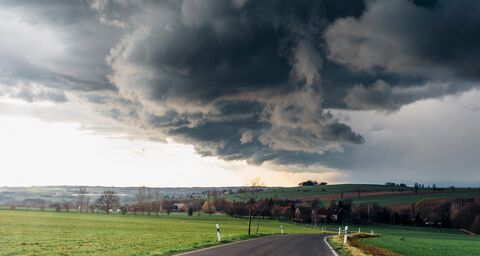
Parking your bike for the winter: what you need to know
As winter draws near each year, motorcycle owners start to think about how they can protect their pride and joy from the elements during the cold weather. Storing your bike for the winter, also known as "winterization," ensures that it will keep working properly and last a long time.
So why is winterization so important? Conditions in the colder part of the year can seriously damage your bike. Winterization has these advantages:
- Protection against corrosion: Salt, snow, and moisture are the enemies of every motorcycle. Without protection and appropriate storage, corrosion damage is virtually inevitable.
- Battery protection: The cold can severely affect your battery's performance. Winterization protects it against deep discharge and extends its life.
- Mechanical protection: Rubber parts such as tires and seals can become brittle in the cold. Winterization stops them wearing out too quickly.
- Protection against theft: Storing your motorcycle somewhere safe reduces the risk of theft and vandalism.
- Protection against animals: Rodents and birds can make themselves at home in your bike and damage its cables and hoses.
Can a motorcycle be parked outside over the winter?
Not everyone has a suitable place to store their bike for several months at a time. If you have no other option but leaving it outside, you should at least do your best to keep it safe:
- Cover: Use a high-quality, breathable cover to protect your bike from moisture and dirt. It should be securely fastened to withstand gusts of wind.
- Anti-theft device: Invest in a good lock and use it every time you park your bike outside.
- Stand: If possible, put your motorcycle up on a stand to take the weight off its tires and avoid flat spots. A stable main stand or a mechanic stand is ideal.
- Regular checks: Check up on your motorcycle at regular intervals while it's parked outside. Look for signs of moisture damage, corrosion, and animal activity.
- Storage location: Find the safest possible spot, preferably shielded, like a terrace with a roof over it or an enclosed veranda.
Remember that leaving your bike outdoors should only be a last resort. If possible, a dry garage with good ventilation or a special motorcycle storage facility would offer better protection against those winter risks. You'll be rewarded with a reliable, long-lasting bike.
Where can I store my bike for the winter?
Choosing the right place to park your motorcycle for the winter can affect its condition and performance when spring comes around.
- Self-storage: You can store your motorcycle in your own garage, a shed or any other safe place on your property. That way, you have full control over the storage conditions. If you live in a rented apartment, you might be able to park your bike in the garage under your building.
- Professional facilities: Lots of motorcycle dealers operate storage facilities guaranteeing maximum protection and security. Many of them also offer extra services like battery maintenance and regular inspections, but all of this comes at a cost.
Tips for winterizing your motorcycle
Properly winterizing your motorcycle will protect it against the worst of the cold weather. What do you need to bear in mind? Here's a checklist to help you:
- Paint and bodywork: Start by cleaning your bike thoroughly. Remove all dirt, dead insects, and salt from the paint and bodywork. Then apply a good wax or sealant to protect the paint against moisture and corrosion.
- Engine and transmission: Change the engine oil and oil filter to get rid of old, dirty oil. Grease the chain and other moving parts to prevent corrosion. Check your frost protection to avoid damage due to frost.
- Fuel system: Fill the tank right up with fresh gasoline. Use a stabilizer additive to preserve the quality of the fuel and prevent problems starting the engine in the spring. If your motorcycle has a plastic tank, empty it before winterizing.
- Tires: Clean the tires thoroughly and check their air pressure. If tires stand in the same place for too long, they might get flat spots, so it's a good idea to move your bike a little every few weeks or put it up on a stand.
- Brakes: Check the brake pads for wear and replace them if necessary. Check the brake fluid for condensation and change it if necessary.
- Battery: Remove the battery and store it in a cool, dry place. Occasional charging helps to ensure a long battery life.
Should I put my bike up on a stand for the winter?
Lots of people swear by a stand for the winter, but why?
- Protection against flat spots: Flat spots are caused by pressure building up when the same part of the tire is in contact with the ground for too long. Putting your motorcycle up on a stand reduces the risk of flat spots and extends the life of the tires.
- Easier maintenance: A stand gives you better access to various components, making maintenance and repairs much easier.
How to use a stand safely
Correct use of a stand requires care and the right equipment. Follow these steps:
- Firm floor: Make sure the floor under your stand is firm enough that the stand won't move around.
- Suitable stand: A proper stand is recommended to ensure that your bike is safely supported.
- Lift the bike: Lift carefully and evenly so that the bike is positioned correctly.
- Check stability: You need to be sure that the stand is holding firm and not allowing your bike to wobble. Adjust the position if necessary.
Should you fire up your motorcycle during the winter?
This question sparks a lot of debate among enthusiasts. There are strong arguments both for and against:
Advantages
- Preserving the battery: A short ride can help to charge the battery, making it last longer.
- Getting up to temperature: Running the engine briefly stops condensation forming in the exhaust system and thus prevents rust.
Disadvantages
- Moisture and condensation: If your motorcycle doesn't fully come up to temperature, moisture can build up in the engine and exhaust and cause damage.
- Short bursts are inefficient: Failing to get up to temperature can lead to incomplete combustion, which puts a strain on the engine.
What happens with my motorcycle insurance over the winter?
If you're not put off by a little bad weather and ride all year round, you of course have to pay for insurance for the full year. If you prefer to winterize your bike and wait for the warmer temperatures of springtime, on the other hand, you should think about paying to deposit your license plates at your local driver and vehicle licensing office. This will save you money, but don't forget to pick them up again before the deposit period expires. They could be assigned to a new owner if you don't.
However, you can also save if you take out your motorcycle insurance with AXA with a suspension waiver for the winter months, meaning that you agree not to deposit your license plates at the driver and vehicle licensing office. We'll give you a 20% discount on the premium if you do this.
Please note: If your insurance includes a suspension waiver, this can only be canceled when you change your motorcycle or your policy reaches the end of its term.





